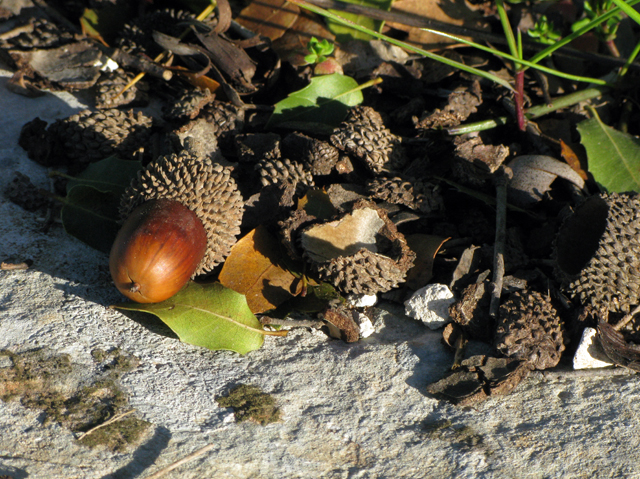 “Let’s go for a walk.” Alex has popped his head around my door, bundled up in coat and hat. I’ve been sitting and staring blankly at my computer screen for hours, and therefore agree with alacrity. It’s been a long week, and fresh air should clear my head. I hastily pull on shoes, grab my coat (which I leave, in daredevil and shockingly un-Italian fashion, unzipped), and follow him out of the flat.
“Let’s go for a walk.” Alex has popped his head around my door, bundled up in coat and hat. I’ve been sitting and staring blankly at my computer screen for hours, and therefore agree with alacrity. It’s been a long week, and fresh air should clear my head. I hastily pull on shoes, grab my coat (which I leave, in daredevil and shockingly un-Italian fashion, unzipped), and follow him out of the flat.
At first, we are mired in tarmac. I long for green English fields and mud. Suddenly, however, we cross a busy, dusty road and, with no warning, are no longer in the town. The endless garishly-coloured blocks of flats, all topped with multiple ugly TV aerials, have disappeared, and we are surrounded instead by stony fields and vineyards. Every so often there is a smallholding, with rows of vegetables growing outside. A dog watches us carefully as we walk past, the arc of his muzzle infinitely slow and smooth, no other movement betraying his almost imperceptible observation of us. It’s not until we’ve completely passed him by that he decides to leap to his feet and bark. It’s as if he’s the early warning system for the lane that we’re on: instantly, up ahead of us there is an answering cacophony of yapping and woofing. It’s not a problem, though. These are Italian dogs and they are therefore chained up outside their owner’s houses. I’m sure if you dared to venture close they’d have your arm off, but we are at a safe enough distance.
The lane narrows, and becomes merely a dirt track. Volcanic rock breaks through the earth from beneath the dust and grass, and dry-stone walls flank us either side. Some are in better repair than others, but even the slightly rickety-looking ones are standing firm. These stones have probably been here since the beginning of time. They may have started out on the ground, but they’ll be placed back into the walls over and over again, a shining example of eco-conscious recycling, by farmers marking the edges of their land. Of course, it has little to do with any concern for the environment. In the same fields, there are piles upon piles of rubbish: an old cast-iron bathtub draped with an old bicycle tyre and sporting a plastic bag flying from one of the taps a particularly notable example.
One wall, a marvel of straight-sided engineering in spite of the irregularity of its component parts, has plastic bottles planted into its top at 3-foot intervals. I can only assume it’s some kind of irrigation system, or maybe a rudimentary bird-scarer. If it’s the latter, it isn’t working very well, as there are clouds of starlings perched in the olive trees next to the wall, scavenging whatever they can find. As we pass by, they launch into the air in a wheeling, chattering, cloud, annoyed at our disturbance of their thievery. The only other birds to be seen are magpies, which pop up everywhere, luckily for the superstitious: it’s far more likely that you’ll run out of rhyme than you’ll see just one for sorrow.
Brushing past a plant growing out of seemingly inhospitable rock, suddenly there is the rich, hot, spicy smell of Indian restaurants. Curry plant! I pinch the leaves and breathe in the scent deeply. Not that I’ve ever really considered its origins, but I don’t think I’d thought of it as Mediterranean. Stupid, really, given that it looks so similar to rosemary and lavender, even if its perfume is somewhat different. A little further along, there is sage and thyme, of varying different types, and bay trees sprout prolifically along the track. There are also acorns strewn liberally underfoot which could, although I’ve never tried them, no doubt be added to a meal somehow. The wild pickings, added to the chillies, olives, vines and other cultivated crops growing in the smallholders’ fields, would make for the most wonderful feast. It’s small wonder that the Italians are known for their food when they have such bounty growing on their doorstep.
We pass what looked from a distance like a small storage barn. On drawing closer, we realise that, in fact, it’s a shrine. The entrance is protected with a locked, ornate, metal gate. Peering through the curlicues and decorations, we see a faded painting on the back wall, of a mitred bishop, flanked by a couple of pilgrims. Round here, it’s quite possibly Sant’Oronzo, although it’s hard to be sure. There are candles melted fatly on the altar in front of whichever saint it happens to be, and faded flowers, left by hopeful supplicants at some time in the not-too-distant past. Christ might have stopped at Eboli, but there is clearly still a need for a mystical higher power. In this sometimes savage scenery, prayers for protection and prosperity abound.
Image: Kate Bailward







Pingback: Travelling without moving – Driving Like a Maniac
Pingback: My 7 Posts – Driving Like a Maniac